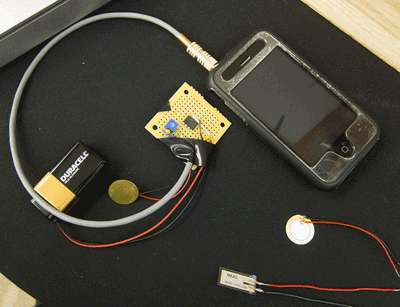How to securely transfer data through your body
AT&T’s research division comes up with unique idea for transferring data
If this concept turns into a reality, you could one day unlock the front door to your home just by touching the handle, or transfer a file, exchange contact information, provide driving directions, and more, simply by shaking an individual’s hand.

AT&T’s bioacoustic data transfer technology. (via: buzzfeed.com)
Researchers at AT&T Labs are working on a technology that combines a mobile device with the owner’s skeletal frame to create a simple yet remarkably secure system for transferring all sorts of data.
Stumbling upon this discovery
The AT&T team did not set out to develop this technology from the get-go. They were originally working on a project where fingertip gestures (tap, rub, etc.) could be identified by a piezoelectric transducer that identifies the different sounds they make.
While testing out the gesture-recognizer, the team had to transmit music through an individual’s body to calibrate the system. While doing this, they realized that this concept — that is, biologically transferring information using vibrations — could be applied to the actual transmission of data in various body-to-object or body-to-body scenarios.
Bioacoustic data transfer: How it works
A piezoelectric transducer is attached to a mobile device: Its job is to send and receive vibration signals. Nothing new, really, but what makes these transducers so special is that each one is configured to send / receive signals specific to the owner’s skeletal profile.
The way this works is the user approaches a data recipient, whether it’s a door handle or another individual. When data is ready to be transferred, a unique “key” signal (e.g., “unlock” key, “file transfer” key, etc.) gets sent from the mobile device to the recipient. If both sides match-up, the piezo-electric transducer in the mobile device translates the to-be-transferred-data into a series of vibrations, and these waves are then sent to the recipient via bone conduction. Actual data transfer takes place at the point of contact, whether it’s gripping the aforementioned door handle or engaging in a friendly handshake.
For the data to be received, the recipient must have their own piezoelectric transducer. This allows for receipt of the vibrations, and subsequent conversion of the waves into information.
Video
In the video below, Brian Amento, Principle Member of Technical Staff at AT&T Research, does an excellent job demonstrating the technology using what can likely be regarded as the world’s first “smart” door handle.
In brief, the way in which this scenario works is the phone used in the video transmits a unique “owner” key to the door handle. When both keys match up, vibrations are sent through Brian’s skeletal system, and the message to unlock the door is received by the door handle when Brian touches it:
Looking forward
Bioacoustic data transfer is an incredibly secure way to transmit information because a person’s skeletal structure, from its overall make up to individual bone density, is unique to every person; that is, everyone has their own skeletal signature, if you will. This means that wavelengths that are identical to one another will emerge differently when passed through two individuals, thus providing auto-encryption of all outgoing data.
It also means that, should the mobile device ever be stolen or lost, it won’t work for anyone except the authorized user. ■
Source: AT&T
Advertisement
Learn more about Electronic Products Magazine





